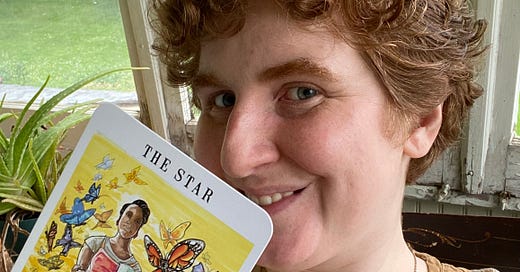Today we are publishing another excerpt from The Star anthology from an essay by KJ Naum called “A Body That Ripples.” In this personal story, KJ describes how queer yoga helps them dismantle systems of oppression through embodiment.
KJ is a writer and artist whose work has appeared in The Rebis: Chariot, as well as Electric Literature, HuffPost Women, and others. They’re currently writing a book called “UNPREDICTABLE: Climate Crisis Wisdom from the Tarot.”
“As an air card representing abstract concepts like ‘hope’ and ‘healing,’ The Star card can feel a little insubstantial to me on a surface level,” KJ explains. “But despite appearances, The Star is hardly an ethereal lady. They're a tough, strong enby who is deeply grounded, who makes the impossible look easy, and whose actions have ripple effects on those around them. They’re someone I work hard to emulate every day. I write about this vision of The Star in my essay for The Rebis, “A Body That Ripples,” where I talk about queer communities, trans liberation, and fart jokes. (I told you this wasn’t ethereal!)”
Thank you to everyone who’s supported The Star anthology! This print issue features more than 30 writers and artists. It’s a beautiful full-color book with 114 pages of essays (like KJ’s!), fiction, poetry, interviews, and original artwork. We redistribute all profits to social justice orgs. Read more about our mission.
A Body That Ripples
by KJ Naum
I don’t go to church on Sundays. I go to a mall in central Illinois that refuses to die. As ‘80s hits echo overhead, I make my way to Defy Gravity, a pole studio tucked away beside a hair salon and a sandwich shop. After taking off my shoes, I join the others laying out yoga mats among the poles, looking forward to one of the most healing moments of my week.
Yoga, as practiced in the United States, is often framed in aspirational terms. If I asked you to imagine a typical yoga class, you might picture thin, athletic women striking pretzel poses in a minimalist studio: a mainstream vision of what well-being looks like. But that’s not the vibe in my yoga class, where half the attendees use they/them pronouns, where we move our bodies under oscillating neon lights, and where our beloved instructor is constantly cackling at her own fart jokes.
It’s not despite its uniqueness, but because of it, that I’ve stuck with this class for years—something I’ve never done with any other yoga class over the two decades I’ve (very casually) practiced it. Oh, sure, I liked the idea of yoga, but the reality never quite worked out. I felt self-conscious among yogis who seemed far more advanced than me, even at beginner levels. Taller and larger than many, I bumped into others around me, all while noticing that the postures achieved by shorter, slimmer people looked different from mine. And despite the obligatory “namaste” at the end, I never found a class where I connected with others. If we recognized the divine within each other, then why were we always in a rush to get through it and leave?
What does this have to do with The Star? This aspirational card has a similar problem. Its ethereal aesthetic often feels all vibes, no substance, at least to me. Common interpretations say it represents “hope” and “healing” without digging into what those words actually mean and —most importantly—the hard and often messy work that goes into cultivating them. A surface-level read of The Star is pure Live Laugh Love, #goodvibesonly, a very palatable image of peace and calm after the chaos of The Tower. Sure, the card’s element is air, which is all about visions and aspirations rather than messy reality. But you know what else is air? A fart.
It isn’t just fart jokes and neon in my yoga class, though. Each week we work toward a particularly challenging asana—“spicy” in our words—discovering all the ways our bodies can bend without pain. In The Star card of the Rider-Waite-Smith deck, a nude blond femme is shown striking an impossible-looking pose: sort of a partial lunge in which their forward leg rests entirely on water, while they carefully pour water from two pitchers. Do their knees hurt like mine do? Are they trembling as they try to maintain their position? Do they feel vulnerable or uncomfortable in their body? This flow is physically demanding, yet they appear completely at ease. You don’t achieve a spicy asana like that without putting in lots of time working up to it.
Similarly, my class moves at such a slow, intentional pace that somebody looking to squeeze in some yoga and rush out would be frustrated. Time gets a little fluid here. Typically, the first 10 or 15 minutes of class are just us talking and joking around before our fearless leader Jamie invites us to go around the room and share our names, pronouns, and how we’re doing. Jamie is not just a person with a dirty mind but also a brilliant listener, and will often respond and draw us out further based on what we’ve shared. Once introductions are complete, we rest in pranayama together. Sometimes 30 or 40 minutes of this 75-minute session pass before we do any asana.
The thing is, though, that half-hour or so is a workout of a different kind, and just as healing. This is the work of building a community. People who would have just been “people I see at yoga” have become friends. It’s no accident that so many of us drawn to this class are queer, adept at finding community wherever we can. It should also come as no surprise that within such a warm, welcoming, queer space, I’ve become more comfortable in my body.
Read the rest of the essay by ordering your copy of The Star.





Speaking as a gen x nonbinary person, this was such a gift to read this morning and a wonderful meditation on the Star card. I especially loved this line: “discovering all the ways our bodies can bend without pain.”